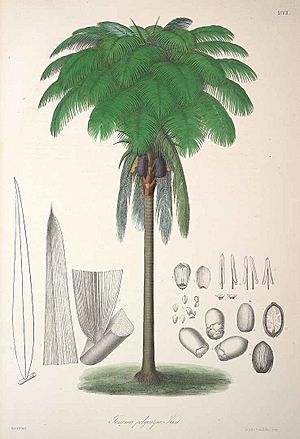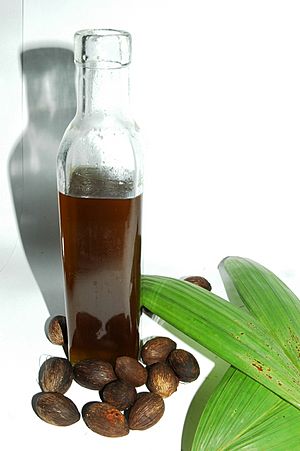Patawa facts for kids
Quick facts for kids Patawa |
|
|---|---|
 |
|
| Scientific classification | |
| Genus: |
Oenocarpus
|
| Species: |
bataua
|
| Synonyms | |
|
|
The patawa palm (scientific name: Oenocarpus bataua) is a tall palm tree that grows in the Amazon rainforest. It's also known by other names like sehe, hungurahua (in Ecuador), or mingucha. This amazing tree produces fruits that are packed with healthy oil. People use these fruits for food, beauty products, and even medicine!
Contents
Where Patawa Palms Grow
Patawa palms are found in the warm, wet rainforests of South America. They grow in places that are less than 1,000 meters (about 3,300 feet) above sea level. You can find them from Panamá and Trinidad all the way to the Amazon basin. This includes countries like Colombia, Venezuela, Guianas, Brazil, Bolivia, Ecuador, and Peru.
There are two main types, or varieties, of patawa palm:
- Oenocarpus bataua var. bataua - Found in Panama and most of South America.
- Oenocarpus bataua var. oligocarpus - Found in Trinidad, Venezuela, and the Guianas.
In the western Amazon, patawa palms are very common. They are one of the top three most frequent palm species. They grow best in soils that don't have too many nutrients. In Colombia, they often grow in sandy soils that get flooded. This might be because fewer other plants compete with them there.
What Patawa Palms Look Like
The patawa palm has a single, straight trunk. It can grow between 10 to 25 meters (about 33 to 82 feet) tall. The trunk is smooth and has ring-like marks. It is about 20 to 30 centimeters (8 to 12 inches) wide.
Each tree has about 10 to 16 large leaves at the top. The stem part of the leaf (called a petiole) is 10 to 50 centimeters (4 to 20 inches) long. The main part of the leaf (called a rachis) can be 3 to 7 meters (10 to 23 feet) long. Each leaf has around 100 small leaflets on each side. These leaflets can be up to 2 meters (6.6 feet) long and 15 centimeters (6 inches) wide.
The palm's flowers grow in a cluster that is 1 to 2 meters (3.3 to 6.6 feet) long. This cluster has about 300 smaller branches, each up to 1.3 meters (4.3 feet) long. The flowers are yellow. Their sepals (outer leaf-like parts) are 2 millimeters long, and their petals are 7 millimeters long.
How People Use Patawa Palms
Patawa fruits are very useful! People use them for many things, including beauty products, food, and even medicines.
Traditionally, people living in the Amazon collect the fruits. They warm them in water to make drinks. They also press the fruits to get out their valuable oil. The fruits are about 8–10% oil. The fresh meolo (the soft inside part of the fruit) can also be eaten.
The strong main stems of the leaves (rachis) have been used to make arrows. The large leaves are also used to weave baskets and build temporary shelters. Some communities also harvest Rhynchophorus palmarum larva (grubs) from the palm. These grubs are a traditional food source.
Patawa Oil Uses
Patawa oil is a special oil. In Amazonian communities, people traditionally use it for cooking, especially for frying foods. In Bolivia, this oil is known as aceite de majo.
The oil is also popular in beauty products. It can be used as a tonic to make hair soft and healthy.
In traditional medicine, patawa oil is used to help treat coughs and bronchitis, which is a chest cold.
See also
 In Spanish: Majo o seje para niños
In Spanish: Majo o seje para niños


